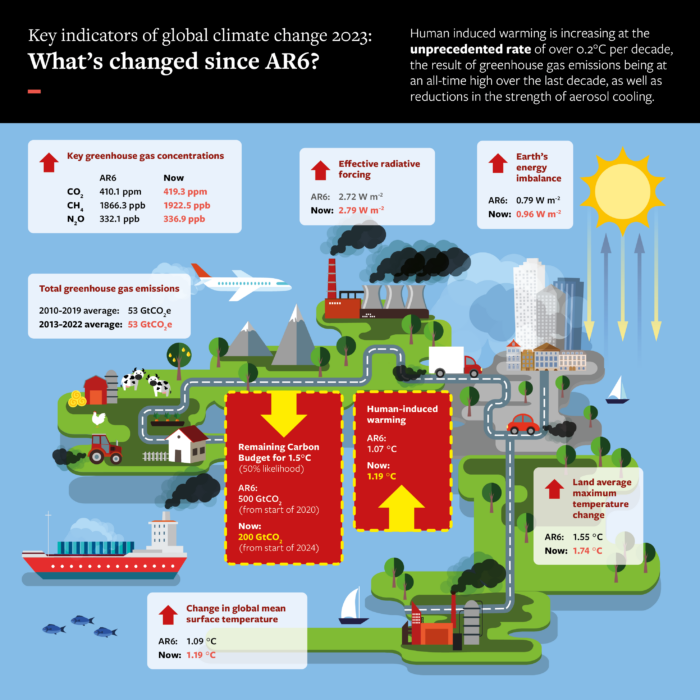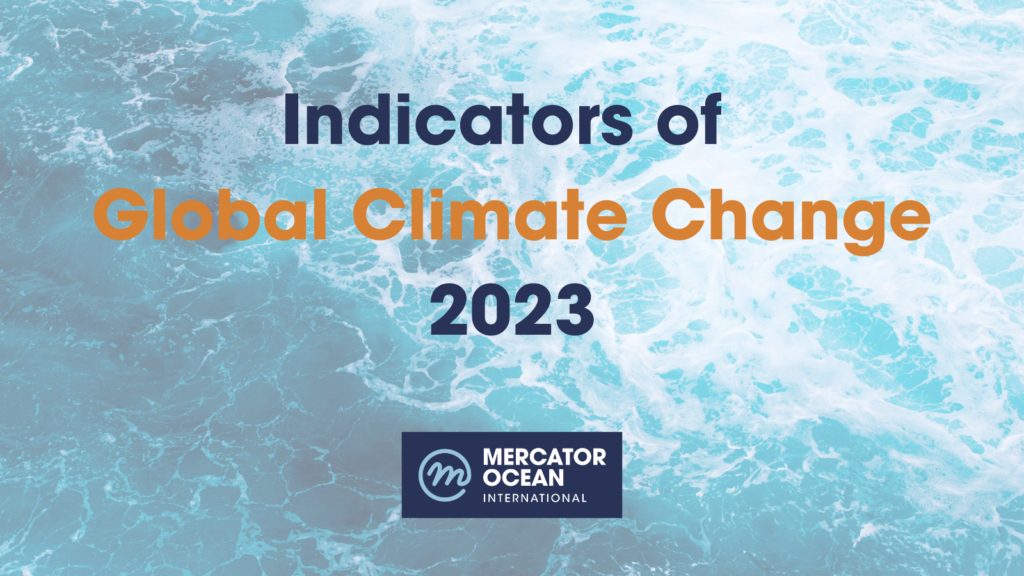An international team of more than 50 leading scientists, including Mercator Ocean’s Karina von Schuckmann, oceanographer specialised in Ocean climate, has presented the second edition of the Indicators of Global Climate Change report. Published in the journal Earth System Science Data, the report includes up-to-date estimates of key climate change indicators. Among the key findings, the authors revealed that human-induced warming is progressing at 0.26 °C per decade, the highest rate on record.
The Indicators of Global Climate Change report is part of the broader Indicators of the Global Climate Change (IGCC) initiative. The initiative aims to bridge the information gap between successive Intergovernmental Panel on Climate Change (IPCC) reports, typically published every 5–10 years, by providing the public with annually updated data adopting the same methodologies of the IPCC.
Key findings of the latest annual report
The report reveals a series of findings based on several global climate change indicators, such as emissions of greenhouse gases and short-lived climate forcers, greenhouse gas concentrations, the Earth’s Energy Imbalance, surface temperature changes, warming attributed to human activities, the remaining carbon budget, and estimates of global temperature extremes.
Human-induced warming is increasing at an unprecedented rate
The second annual report reveals that the temperature increase driven by human activities over the past decade (2014-2023) has risen to 1.19°C. This represents an increase compared to the 1.14 °C recorded in the decade 2013-2022, as illustrated in the first edition of the report.
Even though climate action has slowed the rise in greenhouse gas emissions, this study shows that the level of global warming caused by human action has continued to increase. Specifically, the rate of human-induced warming advanced at the unprecedented rate of 0.26°C per decade over 2014-2023, which is the highest rate since records began. This high rate of warming is caused by a combination of greenhouse gas emissions being consistently high, equivalent to 53 billion tonnes of CO2 per year, as well as ongoing improvements in air quality, which are reducing the strength of human-caused cooling from particles in the atmosphere.
Looking at the single-year average, the report reveals that in 2023, the Earth’s anthropogenic temperature increase was estimated at +1.3°C compared to the years 1850-1900, while the total amount of warming, which accounts for natural factors as well, amounted to 1.43 °C. Natural factors consist in the interactions between the atmosphere, oceans, land and the cryosphere. The report revealed that these factors played a significant role in the record-high temperatures of 2023, in particular the phenomenon known as El Niño.
The Earth Energy Imbalance keeps growing
High greenhouse gases levels are also affecting the Earth’s energy balance: ocean buoys and satellites are tracking unprecedented flows of heat into the Earth’s oceans, ice caps, soils and atmosphere. This flow of heat is 50% higher than its long-term average. More specifically, between 2011 and 2023 the Earth’s heat increase was almost double compared to the period 1976 to 2023. Mercator Ocean’s expert on this subject, Dr. Karina von Schuckman, contributed to the report by leading the Earth Energy Imbalance (EEI) section. The EEI is is the difference between the amount of energy entering the Earth climate system from solar radiation and the energy that is radiated back to space.
How much carbon budget is left before reaching the 1.5°C limit?
Regarding the carbon budget, the analysis shows that society can only release about 200 billion tonnes more of carbon dioxide before the global warming rate reaches 1.5°C, the limit set in the 2015 Paris Climate Accords, hitting a critical point. At the current rate, it would take about four years to reach this amount of emissions. In 2020, the IPCC estimated that between 300 and 900 billion tonnes of carbon dioxide remained to limit global warming to 1.5°C, with a middle estimate of 500 billion tonnes. Since then, the world has continued to emit carbon dioxide, and in parallel, the Earth has continued to warm. As of early 2024, the report shows that the remaining carbon budget is estimated between 100 and 450 billion tonnes.

Why do we need updated climate indicators?
The IPCC’s next major assessment is not expected to be released before 2027, resulting in an important information gap in the following 2 years. With the release of updated information on all major climate indicators, the report can represent a crucial instrument in the hands of policymakers and climate policy makers for informed decision-making, especially for parties involved in the negotiations of the United Nations Framework Convention on Climate Change (UNFCCC).
The team of authors also hopes that the new report will serve as a knowledge base for the new Nationally Determined Contributions, the enhanced climate plans that every country has committed to submit to the UNFCCC by 2025.
What’s next?
As the global community navigates the critical decade of the 2020s, continuous monitoring and updates of climate indicators will be crucial. The report comes as climate experts meet in Bonn to set the ground for the 2024 United Nations Conference of the Parties of the UNFCCC (COP29), which will take place next November in Baku, Azerbaijan.
Mercator Ocean works to create a digital representation of the Ocean, provided data from the past, in near-real time, and forecasts that is dependable, timely, as well as comprehensive indicators to support countries worldwide.
Additional Resources
- Read the second annual report on Indicator of Global Climate Change
- Access the latest Ocean State Report
- Download the research’s supplement
- Visit the research’s datasets
- Read the World Meteorological Organization’s State of the Global Climate 2023
- Check out our Ocean Climate Portal for more Ocean-related climate information
- Learn more about Ocean warming and Earth Energy Imbalance
- Read more articles about recent contributions from MOi oceanographers:
- New study reveals climate change’s toll on fish populations and calls for sustainable fisheries – Mercator Ocean (mercator-ocean.eu)
- New Paper Co-Authored by MOi Oceanographers Reports Record-Breaking Ocean Heat Content Levels In 2023 – Mercator Ocean (mercator-ocean.eu)
- Earth warming has been accelerating for the past 60 years
- A new comprehensive assessment of ocean warming highlights future climate risks, with participation of Mercator Ocean expertise

